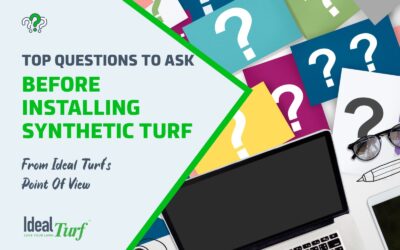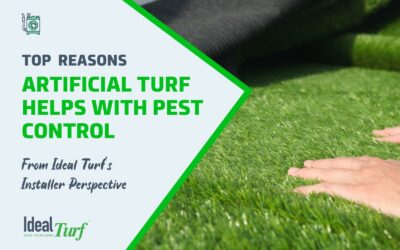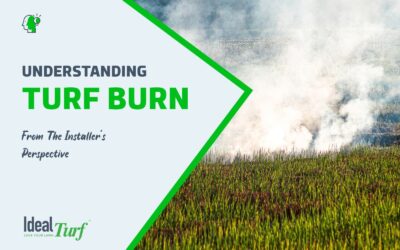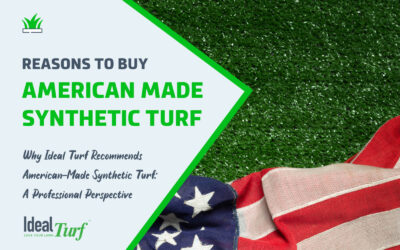A Complete Buyer’s Guide On How To Choose The Best Artificial Grass For Your Space

When artificial grass was invented in the 1960s, there was only one brand and one product: AstroTurf.
Since then, dozens of companies have sprung up offering hundreds of different types of artificial grass—so many, in fact, that shopping for fake grass for your home or business can be a bit daunting.
There’s a surprising amount of information and terminology to learn when you’re shopping for fake grass.
With all the different looks, grades, and prices, you may be wondering how to choose the best artificial grass for your location.
We’ve created this complete buyer’s guide to artificial grass with our new customers in mind.
By the end of this article, you’ll be equipped with all you need to know to confidently choose the best artificial grass for your home, playground, patio, or putting green.

What Are Your Artificial Grass Needs?
Artificial grass is far from a commodity.
There are different types of turf made for specific uses and applications.
This guide will cover the different elements of artificial grass and explain what you should be looking for in an artificial turf product.

How To Choose the Best Artificial Grass for Your Space?
Shopping for synthetic turf can be overwhelming, as there are so many brands, features, and products to choose from.
Here’s a step-by-step guide on choosing the best artificial grass for your space.

1. Research, Research, Research
First of all, research the space the turf will go in.
Will it receive a lot of foot traffic?
Is it prone to puddles or standing water?
Is it in the sun or the shade?
Will it be used by pets?
These questions and more will help you hone in on what features you’ll need in your artificial grass.
Next, research the brands and products available.
Turf distributors and installers should provide you with all the information you want about their synthetic grass products.
To assist with your research, you should check out the following blog posts:

2. Understand Artificial Grass Terminology
Who knew that fake grass could be so complicated?
In this section, we’ll demystify all the specific terminology in the artificial grass world so you can interpret product specifications and find the synthetic turf that will be the best fit for your project.

Yarn
Only three types of yarn are used in artificial grass: polyethylene, polypropylene and nylon.
Polyethylene is the most commonly used because of its versatility and balance between durability, aesthetics, and softness.
Polypropylene is typically used for putting greens and as a thatch layer on landscape grasses.
Nylon is the most expensive and durable yarn material, but it’s not soft and is most commonly used for putting greens.
Yarn comes in a variety of colors, thicknesses, and shapes to mimic specific species of grass.

Density
Also called stitch count, density is the number of blades per square inch.
Similar to thread count in sheets, a denser stitch count signifies a higher-quality turf.
Denser turf products are more durable and provide a more realistic artificial grass lawn.

Pile Height
Pile height refers to how long the blades of artificial grass are.
If you need fake grass for a sports field, dog run, or other high-traffic area, look for a shorter pile height, between ⅜ and ⅝ inches.
A luxurious, true-to-life look for a front yard is achieved by products with a longer pile height, between 1 ¼ and 2 ½ inches.

Face Weight
Face weight refers to how many ounces of material per square yard a type of turf has.
The heavier the face weight, the better quality and more durable the artificial grass is.
Face weight does not include the weight of the backing material.

Thatch
Thatch is additional fiber with varying color, weight, and texture that mimics the inconsistencies of natural grass.
Thatch often includes brown fibers that replicate the dying underlayer of grass beneath the vibrant green, growing one.
If you’re looking for a synthetic grass product for your front or back lawn, a product with thatch will get you the closest look to the real thing.

Infill
Infill plays many roles in keeping your artificial grass pristine.
It keeps fibers upright, acts as a stabilizer to prevent the turf from shifting, and makes the grass look and feel more realistic.
Without infill, turf fibers would quickly become flat and matted.
It also cushions feet and paws that walk on it, as well as protecting the backing from sun damage.
Infill is made from a variety of materials, including silica sand and crumb rubber.
Some brands come with antimicrobial, anti-odor, or cooling properties.

Backing
The backing on synthetic grass has two parts: primary backing and secondary backing.
Both the primary and secondary backings work together to provide dimensional stability to the entire system.
The primary backing is comprised of woven polypropylene fabrics that allow the artificial grass fibers to be tufted into the material in rows and facilitate seaming between artificial grass panels.
In other words it’s the durable material that the grass blades/fibers are stitched to.
A good backing will resist stretching.
The Secondary Backing is often referred to as the ‘coating’ and is applied to the reverse side of the primary backing in order to permanently lock the tufted fibers permanently in place.
Together, the primary and secondary backing make up the back weight.
You can expect to see a back weight above 26 oz. on a high-quality turf product.
A decent back weight is a must for any installation area that will see heavy traffic.

Color
Just as natural grass comes in a variety of colors, so does fake grass.
High-quality artificial grass will include a number of colors to mirror the look of real grass.
Choose a color that most closely mirrors the natural grass species in your area.

Sub-Base
If you try to install artificial grass directly onto soil, you’ll get dimples and wrinkles as the soil expands and contracts during wet and dry seasons.
So while it’s not an official part of your artificial grass, having a good sub-base is critical to a quality turf installation.
The sub-base is a layer of compacted sand, decomposed granite, river rocks and gravel beneath the artificial grass.
It acts as the foundation for your synthetic turf and needs to consist of the right materials to ensure proper drainage.

3. Compare & Contrast Features
Now that you’re familiar with the terminology in the artificial grass world, you’re armed with the knowledge you need to compare the different fake grass products available.
Here are a few specifications you’ll find on each synthetic turf product:
- Thatch Color
- Blade Shape
- Density
- Blade Height
- Drainage
- Antimicrobial Properties
Not all of these features are equally important, however, and the weight of each one will depend on the location and purpose of the installation area.
Read on to know which features are the most relevant for your project.

4. Budget & Finances
An artificial grass installation can be quite a hit to your budget, but it’s important to look at more than just the sticker price when weighing how much you can afford.
When comparing fake grass vs. real grass, the long-term savings on water and maintenance alone enable artificial grass to pay for itself in about three to five years.
Other financial benefits to synthetic turf include less hassle for mowing/weeding/fertilizing, increased home values, and boosted curb appeal.
Many turf companies offer financing options to assist you in your investment in artificial grass.

What Characteristics Should the Best Artificial Grass Have?
Now that we’ve inundated you with everything you need to know, we’ll break down the most important characteristics to look for to find the best artificial grass.
Keep in mind that there is no one “best” product—the ideal turf will be different depending on the installation area and intended purpose.
However, the key elements we cover below are fairly universal.

1. Can Withstand Heavy Foot Traffic / Usage
Different turf products will withstand differing amounts of useage and foot traffic, so choose one that will last through everything you will throw at it.
Will your artificial grass host children?
Or pets?
If so, how many and how frequently?
Keep in mind that while you’ll pay more for extra durability, artificial grass is one of those “buy it nice or buy it twice” purchases.
You don’t want to have buyer’s remorse in just a few years if the turf product you chose isn’t up to the job.
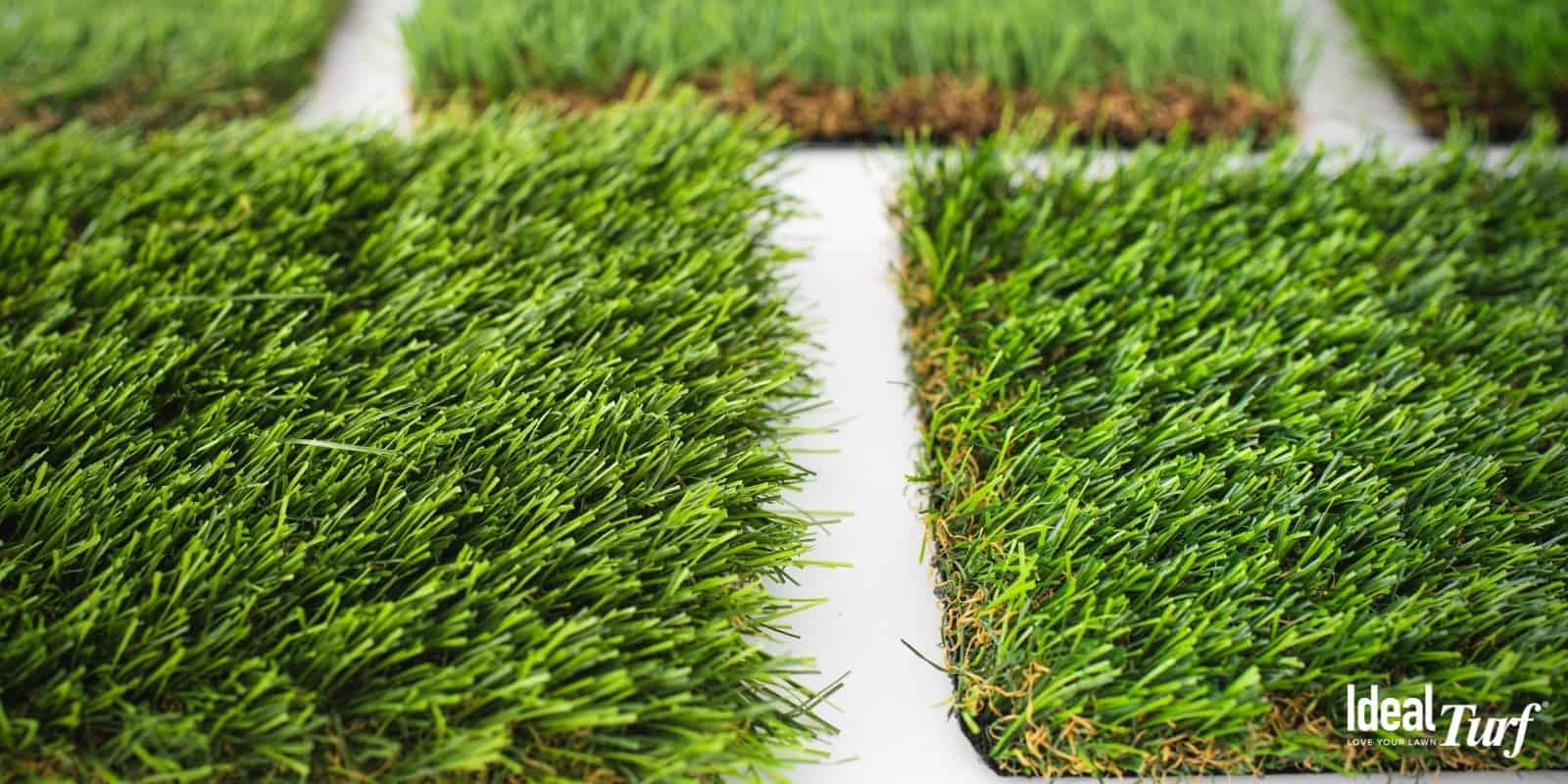
2. Looks Lush & Full
If a lush, full look for the grass is important to you, pay extra attention to pile height, thatch, infill, and density.
Each of these elements add to the natural look of the best artificial grass products.
Also, take care to maintain your synthetic turf regularly with a Power Broom for Turf Rake to preserve the fluffy, plush appearance of your grass and to prevent matting.
To learn more, check out our detailed guide to Artificial Turf Maintenance.

3. Durable & Long-Lasting
It’s easy to forget that artificial grass is out in the heat, cold, sun, dust, and rain 24/7.
Choose a product that has the features that will help it endure through the weather that is common in your area.
Note that the materials used in making artificial turf are extremely durable and able to withstand high-levels of foot traffic for many years with only the occasional hose-down and fluff-up for maintenance.

4. Resilient & Springy
The best artificial grass is engineered to resist matting and maintain its upright appearance.
High-quality turf fibers should spring back into place after being walked on, thanks to both their structural design and the type of infill used.
We recommend using rounded silica sand infill, which helps keep the turf resilient and comfortable—mimicking the feel and look of natural grass.
5. Drainage System
While you might not think about it in the showroom, a quality turf drainage system is an important consideration when choosing the best artificial grass.
It’s important that water and pet urine are able to pass through your turf and into the sub-base below.
In order to do that, the liquids must pass through the turf’s backing.
There are two types of turf backings or drainage systems: 100% permeable and hole-punched.
The 100% permeable backing allows water and pet urine to pass directly through any point in the turf.
This drainage system is ideal for the wet areas of Texas near the coast, as well as lawns with pets or areas prone to flooding or pooling water.
Hole-punched backing has drainage holes every few inches and is best for dry areas that seldom see excess runoff.
We carry a proprietary hybrid drainage system called “DUAL FLOW” that is both fully permeable and hole-punched.

6. Realistic Colors
The beauty of modern synthetic turf is not only how much it looks like natural grass but how closely it can mimic different species of grass.
Take a close-up photo or (if your neighbor will let you) a small sample of grass from a neighboring lawn.
Use this as a guide when choosing a color and texture of artificial grass for your lawn so you can be sure your lawn will match the surrounding ones.

7. Antimicrobial Properties
If you have pets or children on your lawn often, you should strongly consider an artificial grass product with antimicrobial properties.
In these products, antimicrobial additives are added during the manufacturing process.
The antimicrobial backing found on Ideal Turf’s best artificial grass products, called “Microbe Safe” helps to prevent the buildup of odors from pet urine, as well as germs and bacteria, keeping your backyard denizens clean and healthy.

8. Reputable & Trustworthy Turf Installers
Even if you choose the best artificial grass product, a subpar installation can ruin the entire look of your landscaping.
Choose a reputable and trustworthy artificial grass installation company that has experience and expertise in the business.
Check out reviews from multiple sources when comparing turf installers.
The company should be willing to provide you with all the information you want about their turf products and the installation process.

What is the Best Artificial Grass Available?
Different artificial grass products are suited to different applications, so there is no one “best” artificial grass product or brand.
To put it in perspective, if you tried to paint your home’s siding with chalkboard paint or to top your chicken parmesan with strawberry jam, you’d get a less-than-desirable result.
It’s not that chalkboard paint and strawberry jam are bad products, but they are best when used for the intended situation.
Below, we’ll show you what type of turf products work best in specific applications.

The Best Fake Grass for Yards
One of the most common applications of artificial grass is in backyards.
Key features to look for in the best artificial grass for your lawn are a high face weight and long pile height to ensure a nice soft ground cover that’s able to withstand moderate to heavy foot traffic.
We also recommend using a cooling infill (for little feet and paws).
If you see a lot of heavy rain in your area, you should look for turf products with a fully permeable backing or our hybrid “DUAL FLOW” backing to allow for maximum drainage.
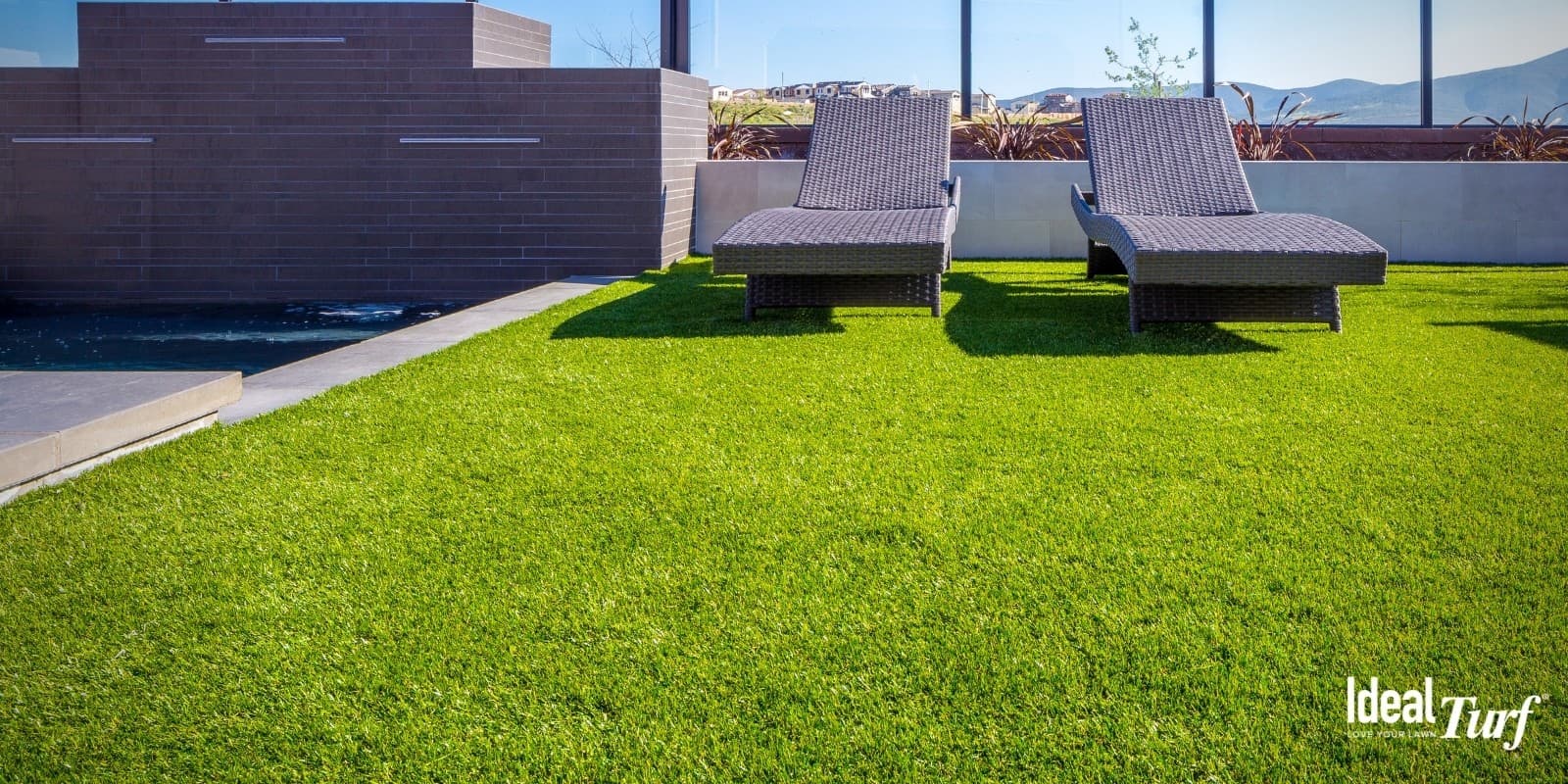
The Best Artificial Grass for Roofs, Decks & Patios
If your downtown apartment, deck or patio needs a little greening up, artificial grass is a great way to do it.
Because it’s installed over concrete or other hard surface, the best fake grass for patios should have a fully permeable backing to allow for draining and deter mold from growing.
Since a small deck or patio won’t see the heavy foot traffic that a yard would, you can afford to go with a short pile height.

The Best Artificial Grass for Dogs & Pets
Fake grass for dogs has exploded in popularity in recent years as homeowners recognize the value of creating a dog-friendly backyard.
Whether you’re considering replacing your entire lawn or looking to build a dog run, the best artificial grass for dogs & pets should have a fully permeable backing to allow pet urine to pass through.
We recommend using T°Cool Infill with dogs and pets because its antimicrobial properties will prevent the buildup of odors and bacteria, and the evaporative cooling will protect your pets paws.
Make sure you choose an infill that is non-toxic to pets.
A short pile height will also enable quick, easy cleanup of solid waste. (Read more about the specifics of artificial grass for pets here.)

The Best Artificial Grass for Around Swimming Pools
Many homeowners choose to install artificial grass around swimming pools.
The best artificial grass for around swimming pools will have a fully permeable backing to allow splashed pool water to drain away rather than puddle up and foster bugs and messes.
Because of all the excess water, antimicrobial additives and a lower face weight are a good idea for artificial turf near pools or backyard ponds.

The Best Artificial Grass for Putting Greens
For an at-home putting green, choose a short pile height, around ½ to ¾ of an inch.
The best putting green turf products will have nylon fibers.
If you want to get fancy, you can choose two different pile heights to differentiate between the putting green and the fairway.
When you have the site prepped for your putting green, make sure there are no rocks, rough spots, uneven areas, or debris as these will affect your golf game.
Also, choose a high-quality infill to allow golf balls to roll consistently across the green.

The Best Artificial Grass for Playgrounds & Play Areas
A fully-permeable backing is ideal for playground turf.
The last thing you need in a children’s play area is stagnant water.
Choose an antimicrobial product to reduce germs, odors, and bacteria.
As for the fake grass itself, the best artificial grass for playgrounds and play areas should have a good thatch layer because it provides extra traction and cushion from falls.
You can even get a base layer of foam underlay for additional padding underneath the artificial grass.
You’ll also want a product with a good face weight so it will be durable enough to withstand continual foot traffic.
Regardless of what brand you choose, make sure the site is well-prepped to ensure there are no rocks or uneven areas beneath the artificial grass installation.
This will increase the life of your play area and prevent injuries from trips and falls.

Wrapping Up How to Choose the Best Artificial Grass
There’s an artificial grass product to fit nearly every climate, use, location, and budget.
But don’t be intimidated by the volume and variety of fake grass products.
Once you know a few terms and features you’ll be well on your way to finding the best artificial grass for your space, whether it’s hearty turf for sports arenas or springy grass for your toddler’s playground.
If you’re interested in an artificial grass installation in Texas or Oklahoma City, please contact Ideal Turf today to get your FREE Artificial Grass Design & Installation Estimate by clicking “GET A QUOTE” button.
We will assess the needs of your location and offer product recommendations for your specific situation.
Feel free to give us a call at 800-204-4650.
Author: Tim Taylor
Recent Posts
- How Synthetic Turf Helps Keep Fleas and Ticks Out of Your Texas and Oklahoma Yard
- Porches, Patios & Personality: Creating Outdoor Spaces Texans Love
- Turn Your Backyard into a Golfer’s Dream: Custom Putting Greens by Ideal Turf
- Why Texas Pet Owners Are Choosing Pet-Friendly Artificial Grass from Ideal Turf
- Why More Texans and Oklahomans Are Turning to Artificial Grass for a Greener Future
